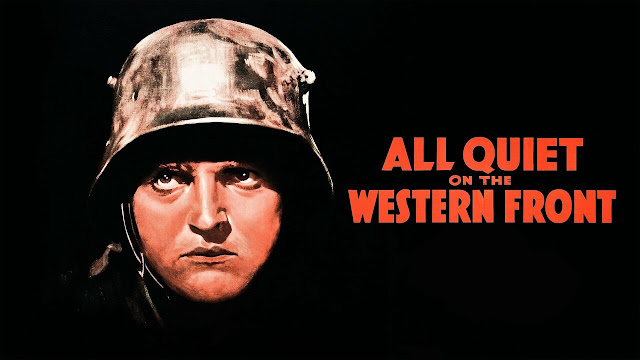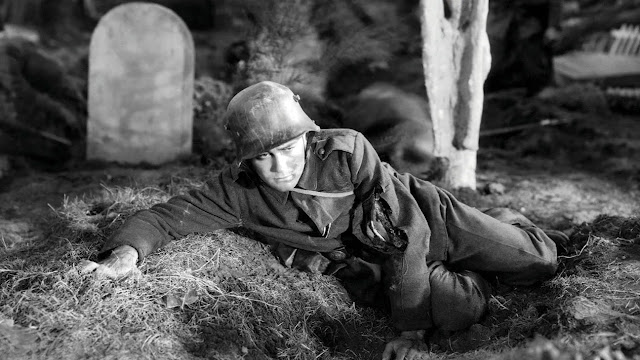This story is neither an accusation nor a confession, and least of all an adventure, for death is not an adventure to those who stand face to face with it. It will try simply to tell of a generation of men who, even though they may have escaped the shells, were destroyed by the war…
These words open up the 1930 Best Picture-winning film All Quiet on the Western Front, a film that dared to do the seemingly impossible and present to audiences, many of whom had either been in the First World War or knew someone who was, with a sympathetic view of the Germans during that terrible war. This is a film that would not have been made twenty years later with the rise of Hitler and the Nazis, and, indeed, with that rise came a ban in Germany on the movie as well as the book it was based on. Not only did this story depict German people as the humans that they are, but it had a very damning view on war in general, something that the rising fascist army in the thirties didn’t take kindly to. The novel was among the books the Nazi party burned, and the film was banned in Germany for many years.
One of the primary targets the film attacks is the general lack of knowledge the people at home had about the realities of war. The film opens in a classroom where several young men that we will follow into the war are in attendance. Their professor, Kantorek (Arnold Lucy), is giving an impassioned address to his students, rousing them up with images of patriotism and heroism, driving them practically into a frenzy to enlist in the military and fight for their country. Each of the young boys, led by Paul Bäumer (Lew Ayres), has a different image of grandeur, a vision that in no way represents what war is really like. This callowness is quickly drowned out when, on their first day on the battlefield, they find themselves being bombed from afar while attempting to lay barbed wire around trenches in the mud. One of them is killed almost immediately, a real wakeup call for the rest of them. None of this misery and death was taught to them in the classroom.
Things only get worse as time goes by and more and more of Paul’s classmates and friends are killed. He begins to question what the whole point of the war is, reflecting on how the Kaiser declares the war and the subjects die fighting it while he watches from afar. Eventually, Paul is granted temporary leave to return home from the battlefront, and what he finds at home is even more disenchanting. The people at home are blissfully unaware of the true horrors of the war, just as he and his friends once were. When he returns to his old classroom, his old professor is still pushing the young men to join the cause and invites Paul to speak. But what Paul has to say only incenses the professor, and the students brand Paul a coward. Disillusioned, Paul returns to the battlefield, now the last of his former classmates still alive.
What’s so striking about this film is the timelessness of it all. It’s in black-and-white, yet it holds up in a way so many of its contemporaries do not. This is a marvel of cinematography, giving us so many wide-angle shots of battles that feel mind-numbingly realistic. This is obviously before the days of CGI, so seeing the staging with explosions inches away from the actors is harrowing. There is one moment where a soldier is grabbing at a barbed wire fence only to be obscured by the dust of an explosion. When the dust clears, there is nothing left but his two hands hanging from the wire, severed at the wrists. Watching the soldiers holed up in a trench hole while the ground shakes around them feels like we are literally there with them, experiencing the trauma and the fear that they are feeling. The ground shakes around them and it creates a sense of claustrophobia as if we are really there.
There are other moments that are effectively shot, too. Paul gets separated from his unit and ends up in a shallow crater while enemy soldiers are leaping over him, unaware he is there. We see this from his point of view, the camera angled upwards to show the enemy as they jump over him. One soldier does see him, though, and leaps down with the intent to kill, only to have Paul stab him in the chest. It takes a long time for that man to die, and in that time, Paul begins to realize that this man, and the many other “enemy” soldiers, are just people, too, sent to fight by a government that doesn’t really care about them.
War is dehumanizing; it’s the nature of it. That crater scene reminded me a lot of the scene in Steven Spielberg’s War Horse when the two enemy soldiers set aside their guns in order to cross into No Man’s Land and free the horse tangled up in the barbed wire. These are men killing each other because their government told them to, not because they want to be doing it. And when they can set that aside, even for a minute, they can see the humanity in each other.
All Quiet on the Western Front has been remade twice and has a sequel. The first remake was a made-for-TV movie in the 1970s. More recently, it got a big-budget German-language film that debuted on Netflix during the tail end of the COVID-19 pandemic. This newest version expands on the themes and the narrative and does such a good job at readapting the novel that it, too, would get nominated for a Best Picture Oscar, becoming one of only a few remakes to achieve that honor. It’s a great movie in its own right, and I will go into greater detail on that picture when I review it at a later date. As good as it is, it isn’t quite as good as the original film, though. There is a degree of realism that just cannot be replicated with modern effects and digital filming.
The ending of this film is the most effective part of the whole narrative and caps off the theme of the entire film. From the opening moments of the film, we get a sense that this is not going to have a happy ending but are not quite sure just how dour it will get. If you haven’t seen this one before, I will not spoil it for you here; just know it is not a happy ending. The image of a butterfly is juxtaposed with the ugliness of war and the generic callousness of killing from afar. It’s simultaneously beautiful and awful at the same time, ending with the two mere inches away from each other.
All Quiet on the Western Front is listed as the first talking war picture to win Best Picture (known at the time as Outstanding Production), but I would argue that it isn’t so much a war picture as it is an anti-war picture. It glamorizes nothing save for the expectations of the new recruits who are signing up for service, blissfully unaware of what it is they are actually getting into. It takes a hard look at a government that ignorantly sends its young men into battle, caring little if they live or die so long as they win in the end. We see that in a moment when the men charge directly into the oncoming machine gun fire, falling in droves, just to gain a little ground on their enemy. This film says a lot about the futility and stupidity of war. Unfortunately, in just a few short years, the whole world would be rallied up again for an even more brutal war, and all of this would get repeated all over again.
Academy Award Nominations:
Outstanding Production: Carl Laemmle Jr. (won)
Best Director: Lewis Milestone (won)
Best Writing: George Abbott, Maxwell Anderson, and Del Andrews
Best Cinematography: Arthur Edeson
____________________________________________________
Release Date: April 21, 1930
Running Time: 133 Minutes
Not Rated
Starring: Lew Ayres and Louis Wolheim
Directed By: Lewis Milestone









Comments
Post a Comment